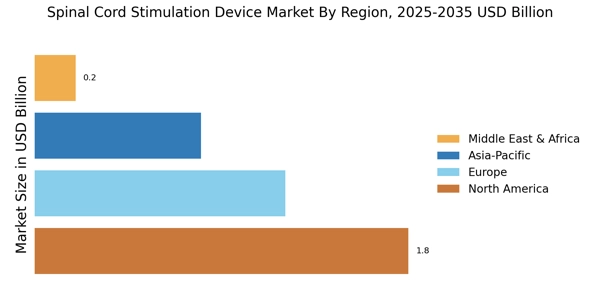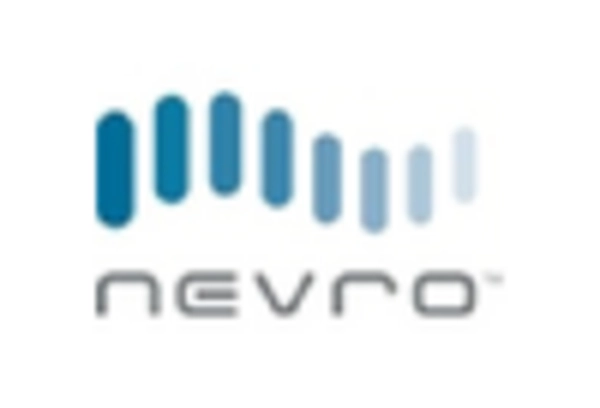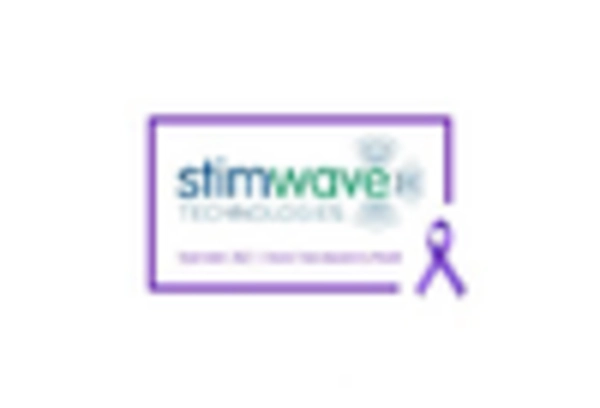Growing Geriatric Population
The aging population is a crucial factor driving the Spinal Cord Stimulation Device Market. As individuals age, they are more susceptible to chronic pain conditions, which often necessitate effective pain management solutions. The United Nations projects that the number of people aged 60 and older will double by 2050, indicating a significant increase in the potential patient base for spinal cord stimulation devices. This demographic shift is likely to create a heightened demand for innovative pain management therapies, including spinal cord stimulation. Additionally, older adults often experience comorbidities that complicate pain management, making spinal cord stimulation an attractive option due to its minimally invasive nature. Consequently, the Spinal Cord Stimulation Device Market is expected to expand as healthcare providers seek to address the unique needs of the aging population.
Rising Healthcare Expenditure
The increase in healthcare expenditure across various regions is a significant driver for the Spinal Cord Stimulation Device Market. As healthcare budgets expand, there is a greater focus on advanced treatment options for chronic pain management. This trend is particularly evident in developed economies, where healthcare systems are increasingly investing in innovative medical technologies. The World Health Organization has reported that healthcare spending is projected to rise, which may lead to increased accessibility and affordability of spinal cord stimulation devices. As more healthcare providers adopt these technologies, the market is likely to experience substantial growth. Furthermore, the emphasis on improving patient outcomes and reducing long-term healthcare costs may encourage the adoption of spinal cord stimulation devices, thereby enhancing the overall market landscape.
Increasing Prevalence of Chronic Pain
The rising incidence of chronic pain conditions, such as neuropathic pain and failed back surgery syndrome, is a primary driver for the Spinal Cord Stimulation Device Market. As more individuals seek effective pain management solutions, the demand for spinal cord stimulators is likely to increase. According to recent estimates, chronic pain affects approximately 20% of the population, leading to a substantial market opportunity. This growing patient population is expected to propel the adoption of spinal cord stimulation devices, as they offer a minimally invasive alternative to traditional pain management methods. Furthermore, the increasing recognition of the efficacy of spinal cord stimulation in alleviating pain may further enhance its market penetration. Consequently, the Spinal Cord Stimulation Device Market is poised for growth as healthcare providers seek innovative solutions to address the needs of patients suffering from chronic pain.
Enhanced Patient Outcomes and Satisfaction
The focus on improving patient outcomes and satisfaction is a driving force in the Spinal Cord Stimulation Device Market. Studies have shown that spinal cord stimulation can lead to significant reductions in pain levels and improvements in quality of life for patients with chronic pain. As healthcare providers increasingly prioritize patient-centered care, the demand for effective treatment options like spinal cord stimulation is likely to grow. Furthermore, positive patient experiences and testimonials can influence the adoption of these devices among new patients. The potential for spinal cord stimulation to reduce reliance on opioid medications also aligns with current healthcare trends aimed at combating the opioid crisis. As a result, the Spinal Cord Stimulation Device Market is positioned to benefit from the ongoing emphasis on enhancing patient care and outcomes.
Technological Innovations in Device Design
Technological advancements in spinal cord stimulation devices are significantly influencing the Spinal Cord Stimulation Device Market. Innovations such as closed-loop systems, which automatically adjust stimulation based on patient feedback, are enhancing the effectiveness of these devices. Additionally, the development of smaller, more efficient devices with improved battery life is making spinal cord stimulation a more appealing option for patients. The integration of wireless technology allows for remote monitoring and adjustments, further increasing patient satisfaction and compliance. As these technologies continue to evolve, they are likely to attract more patients and healthcare providers to consider spinal cord stimulation as a viable treatment option. The ongoing research and development in this field suggest a promising future for the Spinal Cord Stimulation Device Market, as new features and functionalities are introduced to meet the diverse needs of patients.


















Leave a Comment